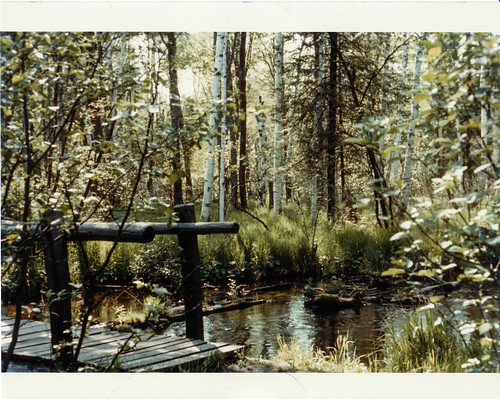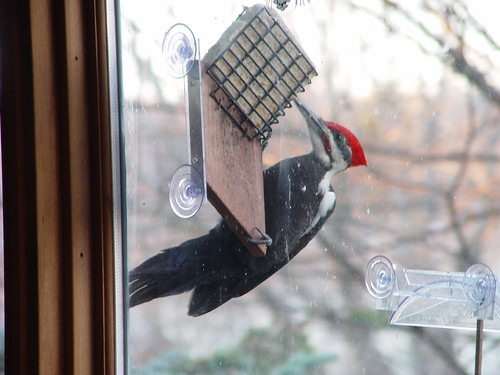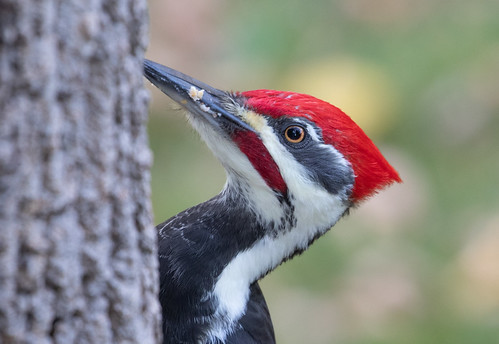I went all of 1975 and through five months of 1976 without seeing one, and then on the magical evening of June 5, 1976, one flew past me close enough that I could feel the wind from its beating wings in my face, and it alighted on a tree close enough that Russ got an identifiable photo of it with his macro lens.
 |
| You have to look carefully at the very bottom of the birch snag just above to the right of the bridge handrail. |
Pileateds were few and far between for me in my first years of birding, though as time has gone by and I’ve done more traveling, I have managed to see them in two provinces (British Columbia and Ontario) and 10 states (California, Delaware, Florida, Georgia, Kentucky, Maine, Massachusetts, New Hampshire, Oklahoma, and South Carolina) in addition to, of course, Minnesota and Wisconsin.
It took years to add the species to my yard list here in Duluth, but in the past two decades, they’ve become very regular indeed, and I’ve gotten lots of photos.
 |
| First photo ever in my own backyard, at my window feeder! |
But even as they’ve grown almost commonplace in many places in recent years, there’s something breathtakingly astonishing about them nonetheless. Even my non-birding daughter and son-in-law have both not only noticed them out the window but taken iPhone photos in the past few months. How could they not?
It’s exactly as ABA President Jeff Gordon wrote about them in the January issue of Birding: “Pileated Woodpeckers have gone from seeming like supernovae to something more like the full moon: impressive and enchanting, and mysterious, yes, but neither rare nor unpredictable.”
"Astonishing" is an excellent description of Pileateds, fitting even mundane facts about how tenaciously they cling to trees. Early American ornithologists noted that when shot while on a tree trunk, they didn’t fall for a long time, until their muscles relaxed.
My own experiences with wild Pileateds have been a little less firearm intensive. In 1988, I wrote about spending time watching Pileated Woodpeckers on Burntside Lake at the edge of the Boundary Waters. I wrote:
The most satisfying times I had were when I sat down to watch for 30 minute stretches. I saw one father Pileated feeding his daughter and teaching her how to dig for her own insects in the tree bark. I could tell he was the father because he had a red mustache and his red crest began where his beak ended. Her mustache and forehead were black–the red feathers of her crest started further back on her head.Then I watched an adult female–presumably the mother–take a half-hour break one hot afternoon. She made the pileated yell as she landed in a dead spruce, presumably to tell her family where she was. Then whenever one of the others called, she turned her head to get a fix on the direction but kept quiet herself. She preened her right wing, picked for a few bugs, and moseyed along the tree trunk, occasionally peeking at me. She may well have been furtively studying me, taking notes on the everyday lives of adult female humans, and how they laze around on the edge of a dusty road and don’t do much of anything on a hot afternoon.
At that point, my experiences with Pileated Woodpeckers were still rare enough to feel like I was experiencing supernovae, as Jeff Gordon so beautifully put it. Now seeing them may be more regular and almost commonplace, like that full moon, but their magnetic pull draws my beating heart ever toward them as the full moon draws the ocean's tides.



